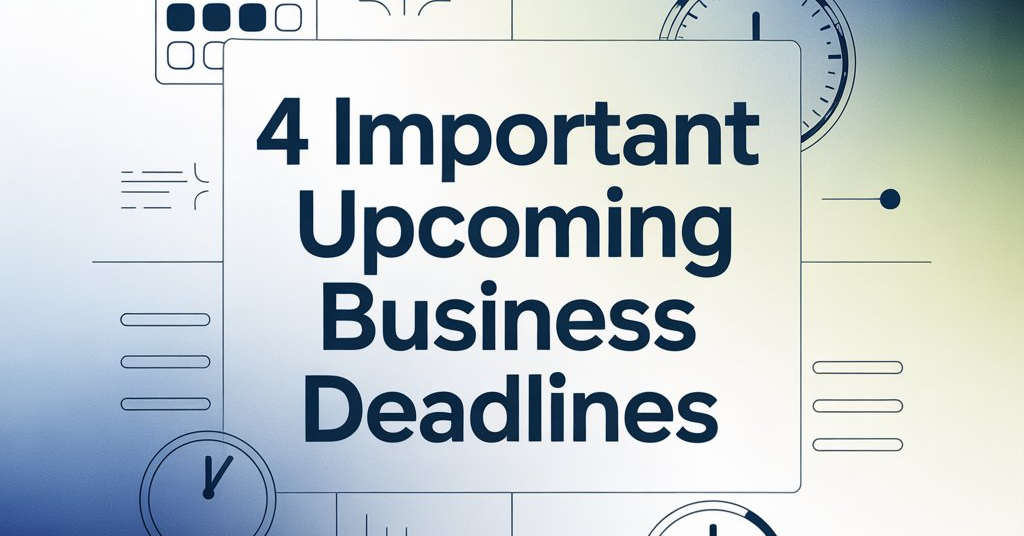Running a business is not just about profits and operations—it also comes with responsibilities like paying taxes on time. Missing tax deadlines can lead to penalties, fines, and unnecessary stress. In 2025, there are 4 important upcoming business deadlines that every business owner, whether a sole proprietor, partnership, S-corp, or C-corp, must be aware of.
In this guide, we will explain these deadlines clearly, provide examples, show calculations for estimated taxes, and share tips to help you stay compliant.
4 Important Upcoming Business Deadlines
1. March 17, 2025 – Partnership and S Corporation Tax Returns
If your business is a partnership or S corporation, March 17, 2025, is the deadline to file your tax returns.
- Partnerships file Form 1065 (U.S. Return of Partnership Income)
- S Corporations file Form 1120-S (U.S. Income Tax Return for an S Corporation)
This date is important because it is the 15th day of the third month after the end of the tax year for calendar-year businesses. Filing late can result in penalties.
Example
- Suppose you run a partnership called “Bright Future Partners” with a calendar year ending December 31, 2024.
- You need to file Form 1065 by March 17, 2025.
If you fail to file on time, the IRS can charge a $210 penalty per partner per month. For example, if your partnership has 3 partners and you file 2 months late:

This is why filing on time is crucial.
Tip: If you need more time, submit Form 7004 to get an extension, but note that an extension to file does not extend the time to pay taxes owed.
2. April 15, 2025 – Sole Proprietor and C Corporation Tax Returns
The April 15 deadline is essential for sole proprietors and C corporations.
- Sole Proprietors: Report income and expenses using Schedule C attached to Form 1040.
- C Corporations: File Form 1120 to report corporate income.
This date applies to calendar-year businesses, and missing it can trigger penalties and interest on taxes owed.
Example
- Suppose you are a sole proprietor running a small bakery, “Sweet Treats,” with total annual income of $120,000 and expenses of $50,000.
- Your taxable income will be:
120,000−50,000=70,000
- If your tax rate is 22%, your tax liability is:
70,000×0.22=15,400
- You must pay $15,400 by April 15, 2025.
For a C corporation with a net profit of $200,000 and a corporate tax rate of 21%, the tax calculation is:
200,000×0.21=42,000
Paying this on time avoids penalties and interest.
3. June 16, 2025 – Second Quarter Estimated Tax Payments
Many business owners, especially self-employed individuals, LLCs, or corporations that expect to owe $500 or more in taxes, must make quarterly estimated tax payments.
- First quarter: Already passed (April 15)
- Second quarter: Due June 16, 2025
- Third quarter: September 15, 2025
- Fourth quarter: January 15, 2026
Quarterly payments prevent large balances at tax time and reduce penalties.
Example
- Suppose you expect to owe $2,000 in total taxes for 2025.
- You divide it into 4 quarterly payments:
2,000÷4=500
- Second quarter payment due June 16, 2025: $500
Paying late may lead to underpayment penalties.
4. September 15, 2025 – Third Quarter Estimated Tax Payments
The third-quarter estimated payment covers the period from June 1 to August 31. It is due on September 15, 2025.
Example
- Using the previous example, your third-quarter payment is $500.
- Paying on time keeps your business in compliance and avoids unnecessary fees.
Tip: Keep a calendar or reminders for all quarterly payments to avoid missing deadlines.
Additional Important Points for Business Owners
1. Keep Accurate Records
- Maintain detailed records of income, expenses, receipts, and invoices.
- Accurate bookkeeping ensures correct tax filing and reduces audit risk.
2. Use Accounting Software
- Software like QuickBooks, Xero, or Zoho Books helps track finances and calculate estimated taxes automatically.
- Many software options allow reminders for upcoming deadlines.
3. Understand Extensions
- Filing extensions (Form 7004) give extra time to file, not extra time to pay taxes.
- Always pay at least estimated taxes owed by the original deadline.
4. Consult a Tax Professional
- Taxes can be complex, especially for partnerships and corporations.
- A CPA or tax advisor can help you:
- Avoid penalties
- Maximize deductions
- Plan for future tax years
- Avoid penalties
5. Penalties for Late Filing
| Type of Business | Penalty | Example |
| Partnership/S Corp | $210 per partner/month | 3 partners, 2 months late = $1,260 |
| Sole Proprietor | 5% of unpaid taxes per month | $15,400 tax liability, 1 month late = $770 |
| C Corp | 5% per month on unpaid tax | $42,000 tax liability, 1 month late = $2,100 |
Real-Life Scenario
Imagine you run a small IT consulting firm, operating as an S corporation. You have:
- 2 partners
- Net income: $100,000
- Expected taxes: $21,000
Deadlines:
- March 17, 2025: File Form 1120-S
- Quarterly Payments: April 15 ($5,250), June 16 ($5,250), September 15 ($5,250), January 15, 2026 ($5,250)
If you miss the March 17 deadline by 1 month:
2{ partners} × $210 = $420
Plus, underpayment penalties on estimated taxes may apply. Staying organized avoids all this hassle.
Also Read: Making the Most of the Instant Asset Write Off: A Guide for Small Businesses
Conclusion
Paying attention to business tax deadlines is vital for every business owner. The four key deadlines in 2025—March 17, April 15, June 16, and September 15—cover partnerships, S corporations, sole proprietors, C corporations, and estimated tax payments.
- Missing deadlines leads to penalties and interest.
- Accurate bookkeeping, accounting software, and tax professional advice can save money and stress.
- Mark your calendars and plan ahead to keep your business compliant and financially healthy.
By understanding and following these deadlines, your business can avoid penalties, maintain a good standing with the IRS, and focus on growth.



